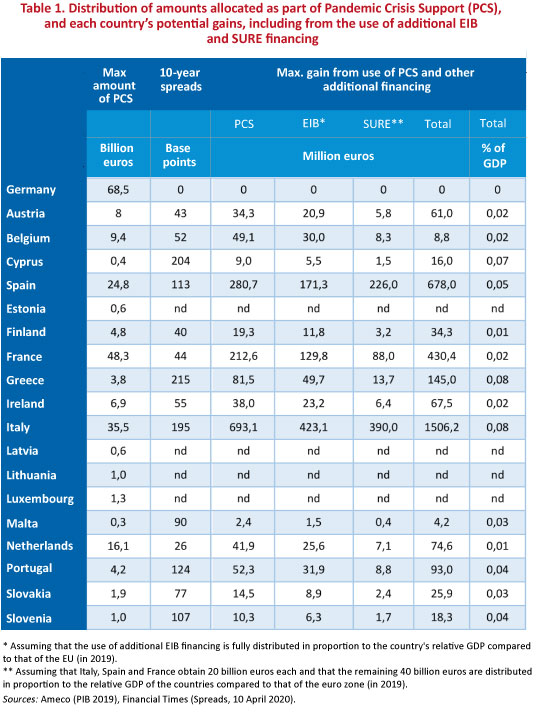It seems like it’s raining billions
Jérôme Creel, Xavier Ragot, and Francesco Saraceno
The second meeting of
the Eurogroup did the trick. The Ministers of Finance, after having once again laid
out their divisions on the issue of solidarity between euro area Member States on
Tuesday 7 April 2020, reached an agreement two days later on a fiscal support plan
that can be put in place fairly quickly. The health measures taken by the Member
States to limit the spread of the Covid-19 pandemic will enjoy better
short-term financing, which is good news. The additions to Europe’s tools for
dealing with the crisis will be on the order of 500 billion euros – this is
certainly not negligible, and note that this comes on top of the efforts
already put in place by governments – but this corresponds mainly to a new
accumulation of debt by the Member States. The net gain for each of them, as we
shall see, is actually quite marginal.
The Eurogroup will
propose the creation of a credit line (Pandemic Crisis Support) specifically
dedicated to the management of the Covid-19 crisis within the framework of the
European Stability Mechanism (ESM), without strict conditionality (meaning that
recourse to the credit line will not imply any control on the part of the EMS
over the future management of the Member State’s public finances). The creation
of the credit line was inspired by the proposal by Bénassy-Quéré et al. (2020), the advantages and disadvantages of which we presented to the Eurogroup meeting on
9 April 2020. The amount allocated to this credit line represents around 2% of
the GDP of each euro area Member State, or nearly 240 billion euros (in 2019
GDP).
The lending mechanism
proposed by the European Commission to supplement the partial unemployment
programmes of the Member States – it goes under the name of SURE – will clearly see the light of day and will be
endowed with 100 billion euros. For the record, the three main beneficiaries of
SURE cannot receive a combined total of more than 60 billion euros in loans.
Finally, the European
Investment Bank (EIB) will grant an additional 200 billion euros, mainly to
small and medium-sized enterprises in the EU Member States. In total, the euro area
countries will have 480 billion euros in additional financing capacity.
Table 1 below
presents a breakdown by country of the amounts in play. As part of the 240
billion euros of Pandemic Crisis Support, Germany will be able to benefit from
a borrowing capacity of nearly 70 billion euros, France nearly 50 billion
euros, and Italy and Spain 35 and 25 billion euros respectively. These amounts
correspond to 2% of the 2019 GDP of each country. At this point, there is no
indication of whether the Member States will draw on this capacity. The
advantage in doing so depends crucially on the difference between the interest
rate at which they can finance their health and economic expenses without using
the EMS and the interest rate on loans made by the EMS. The financing cost without
going through the EMS is the interest rate on the country’s public debt. The
cost of financing through Pandemic Crisis Support is the interest rate at which
this credit line is itself financed, that is to say, at the lowest rate on the
market, i.e. the German rate. So it is obvious that Germany has no interest in
using this credit line. Of the 240 billion euros allocated to Pandemic Crisis
Support, the 70 billion euros for Germany is thus useless. For countries other
than Germany, the use of Pandemic Crisis Support depends on the difference between
their interest rate and Germany’s rate, the infamous spread. If the spread is
positive, using the EMS effectively reduces the cost of borrowing. But as shown
in Table 1, the gain enabled by Pandemic Crisis Support is rather low. For
Greece, whose spread vis-à-vis Germany is the highest in the euro zone, the
gain would come to around 0.04% of GDP in 2019, i.e. a 215 basis point spread
multiplied by the amount allocated to Greece for Pandemic Crisis Support (3.8
billion euros, which corresponds to 2% of its GDP of 2019), all relative to its
2019 GDP. For Italy, the gain is on the same order: 0.04% of its GDP. Expressed
in euros, Italy stands to gain 700 million euros. For France, whose spread
vis-à-vis Germany is much lower than that of Italy, the gain could be 200
million euros, or 0.01% of its GDP in 2019.
Assuming that the amounts allocated by the EIB are prorated to the country’s size (measured by its GDP in 2019), and that Spain, Italy and France benefit from 20 billion euros each under SURE, the total interest rate savings would reach, respectively, 680 million, 1.5 billion and 430 million euros (0.05%, 0.08% and 0.02% of GDP). At a time when it seems to be raining billions, these are not big savings. Unless you think of it as a metaphor. Like rain before it falls, the billions of euros are not really euros before they fall.
